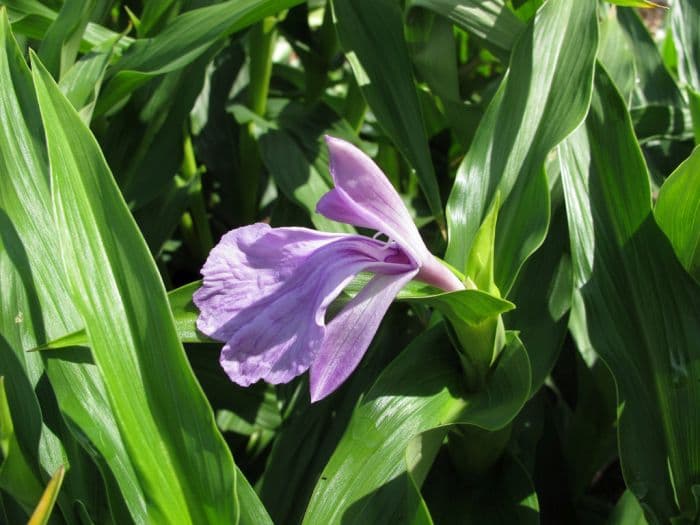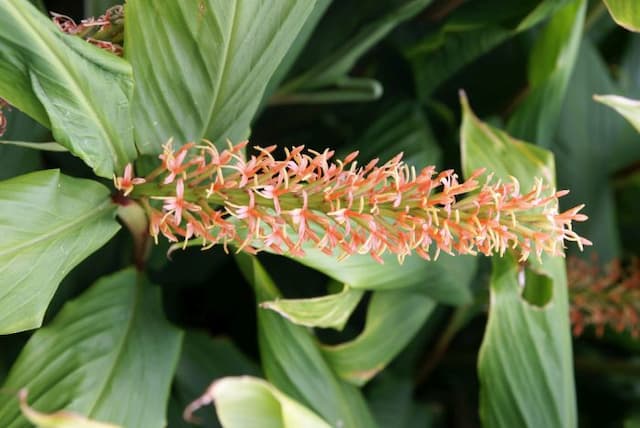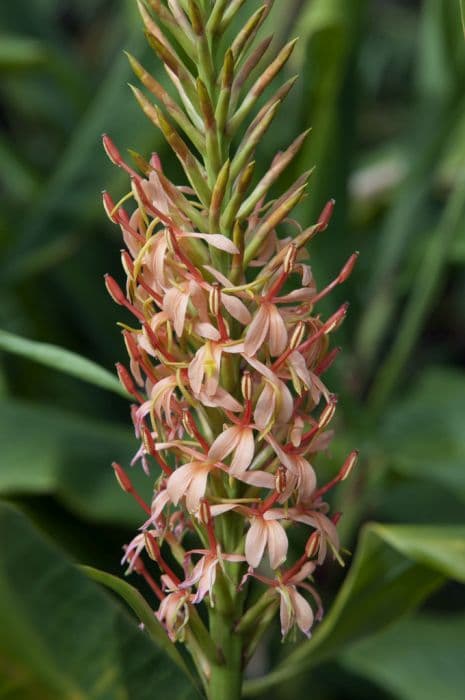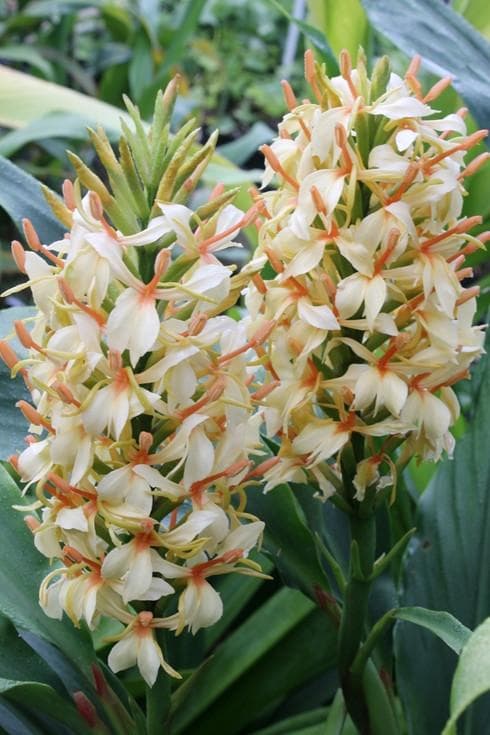Peacock Plant Roscoea purpurea 'Peacock'

ABOUT
Roscoea purpurea 'Peacock', commonly known as the Peacock ginger, is an herbaceous perennial that boasts a striking appearance. The plant is characterized by its vibrant and exotic flowers. Each bloom displays a luscious shade of purple that may remind one of the iridescent colors reflected in peacock feathers. The petals are typically broad and funnel-shaped, exuding an elegant poise as they perch atop the slender, upright stems, which carry them with a grace that befits their peacock moniker. The foliage of the Peacock ginger is equally attractive, featuring lance-shaped leaves that form a lush, green backdrop, creating a striking contrast against the purple flowers. These leaves can have a somewhat glossy surface, adding to the plant's overall allure. The presence of these generously sized leaves often contributes to a dense and full appearance, making the plant an excellent choice for adding texture and color to garden spaces. Together, the regal flowers and rich green leaves create a visual spectacle that brings a touch of exotic charm to wherever the Peacock ginger grows, enticing onlookers with its deeply hued blossoms and verdant foliage.
About this plant
 Names
NamesSynonyms
Peacock Roscoea, Purple Roscoea, Purple Dragon.
Common names
Roscoea purpurea 'Peacock'.
 Toxicity
ToxicityTo humans
Roscoea purpurea, commonly known as 'Peacock' ginger, does not have a well-documented profile of toxicity to humans. There is limited information available on its poisonous nature or the symptoms of poisoning in humans. However, as a general rule with any plant, if there is uncertainty about its safety, it is prudent to avoid ingesting any part of the plant and to keep it out of reach of children who might accidentally consume it.
To pets
Roscoea purpurea, commonly referred to as 'Peacock' ginger, is not widely recognized for being toxic to pets. There is insufficient evidence to suggest that this plant is poisonous to animals. However, as with any plant not known to be safe for consumption, it is wise to prevent pets from ingesting it to avoid any potential adverse reactions or gastrointestinal upset.
 Characteristics
CharacteristicsLife cycle
Perennials
Foliage type
Deciduous
Color of leaves
Green
Flower color
Purple
Height
1-2 feet (30-60 cm)
Spread
0.5-1 feet (15-30 cm)
Plant type
Herb
Hardiness zones
6
Native area
Asia
Benefits
 General Benefits
General Benefits- Aesthetic appeal: Roscoea purpurea 'Peacock', commonly known as Roscoea, produces beautiful purple flowers, which can enhance the visual appeal of gardens and landscapes.
- Attracts pollinators: The vibrant flowers of the Roscoea attract bees and butterflies, which are essential for the pollination of plants and the health of the ecosystem.
- Low maintenance: Roscoea is known for being a low maintenance plant, making it suitable for gardeners of all skill levels.
- Drought tolerance: Once established, Roscoea can be relatively drought-tolerant, requiring minimal watering in the right climates.
- Shade tolerance: This plant can thrive in partial shade, making it a good choice for planting under trees or in areas with filtered sunlight.
 Medical Properties
Medical PropertiesThis plant is not used for medical purposes.
 Air-purifying Qualities
Air-purifying QualitiesThis plant is not specifically known for air purifying qualities.
 Other Uses
Other Uses- The rhizomes of Roscoea purpurea, commonly known as the Roscoea, can be used as a natural dye source for textiles, providing colors ranging from yellow to deep orange depending on the mordants used.
- Roscoea's large leaves can act as a natural wrapping material for small items, similar to how banana leaves are used in various cultures.
- The fibrous parts of the plant, including leaves and stems, can be incorporated into handcrafted paper, giving it a unique texture and appearance.
- Roscoea's sturdy stalks can serve as garden stakes for supporting other plants in the garden that require assistance to remain upright.
- Some enthusiasts of miniature gardens or fairy gardens utilize the Roscoea's distinct flower shape to create a sense of fantastical scale and interest in their creations.
- The crushed leaves of Roscoea can produce a natural insect-repellent mixture, although it may not be as efficient as commercial repellents.
- During bloom time, Roscoea flowers can be floated in bowls of water for ornamental purposes, providing a delicate and fragrant decoration.
- The plant's seed pods, once dried, can be added to rattles or other musical instruments to create a soft, gentle sound for recreational or ceremonial use.
- Roscoea can be used in educational settings to teach about pollination and the reproductive cycle of plants due to its clear and distinct flower structures.
- For artists, the unique form and color of Roscoea can inspire intricate botanical illustrations or serve as a reference for botanical sculpting.
Interesting Facts
 Feng Shui
Feng ShuiRoscoea is not used in Feng Shui practice.
 Zodiac Sign Compitability
Zodiac Sign CompitabilityRoscoea is not used in astrology practice.
 Plant Symbolism
Plant Symbolism- Exotic Beauty: The Roscoea purpurea 'Peacock', commonly known as Peacock Ginger, exhibits vibrant and striking colors akin to the beauty of a peacock, symbolizing unique and spectacular attractiveness.
- Rarity and Uniqueness: As a less common garden plant, the Peacock Ginger represents rarity and the value of what is uncommon or unique in life.
- Adaptation: This plant thrives in a variety of conditions, indicating the ability to adapt and flourish in different environments, much like the resilience and adaptability embodied by its namesake, the peacock.
- Mysticism and Allure: With its intricate patterns and exotic demeanor, Peacock Ginger embodies a sense of mysticism and allure, often associated with the mystical qualities of the animal world and the rich narratives of Eastern cultures where such patterns are prevalent.
 Water
WaterRoscoea purpurea, commonly known as Hardy ginger, should be watered deeply to ensure that the soil becomes moist but not waterlogged. In the growing season, typically spring and summer, water the plant once or twice a week, depending on the weather conditions. On average, this would translate to about 1 inch of water per week or approximately 0.623 gallons for a medium-sized plant. During the dormant period in fall and winter, reduce watering to every couple of weeks, just enough to prevent the soil from completely drying out. Always check the soil moisture level before watering to avoid over-watering.
 Light
LightHardy ginger thrives in partial shade where it can receive dappled sunlight. The best spot for this plant would be in a garden that gets some morning sun and shade in the afternoon, or beneath the canopy of taller plants that filter the intense midday sun. Avoid placing it in full sun as this can scorch the leaves and stress the plant.
 Temperature
TemperatureHardy ginger prefers moderate temperatures and can suffer if exposed to extremes. It can survive minimum temperatures down to about 20°F, but ideally, it should be kept in conditions that do not drop below 40°F. The maximum temperature for this plant should not exceed 90°F with the ideal temperature range being 60°F to 75°F for optimal growth and flowering.
 Pruning
PruningHardy ginger does not require extensive pruning. Pruning is usually done to remove any spent flowers or damaged leaves to maintain plant health and appearance. This can be carried out as needed throughout the growing season. The best time for more significant pruning is in late winter or early spring before new growth starts, to tidy up the plant and encourage fresh growth.
 Cleaning
CleaningAs needed
 Soil
SoilThe best soil mix for Roscoea purpurea, commonly known as the Hardy Ginger, should be rich, well-draining, and humus-enriched with a slightly acidic to neutral pH of 6.0 to 7.0. A good recipe is to mix one part garden soil, one part compost or leaf mold, and one part perlite or sand to ensure good drainage and fertility.
 Repotting
RepottingThe Hardy Ginger should be repotted every 2-3 years or when it's evident that the plant has outgrown its current pot, typically seen when roots are growing through the drainage holes. Spring is the best time to repot to encourage growth during the growing season.
 Humidity & Misting
Humidity & MistingThe Hardy Ginger thrives in moderate humidity levels. It generally does well with the average indoor humidity level but if the air is too dry, particularly during winter heating, occasional misting or a humidity tray can help maintain adequate moisture in the air around the plant.
 Suitable locations
Suitable locationsIndoor
Keep Hardy Ginger in bright, indirect light with moderate humidity.
Outdoor
Plant Hardy Ginger in partial shade, ensure well-draining soil.
Hardiness zone
6-9 USDA
 Life cycle
Life cycleThe life of the Roscoea purpurea 'Peacock', commonly known as the Peacock Ginger, begins with germination of its seeds in moist, well-drained soil during spring. As a perennial, the plant emerges from rhizomes with leafy shoots that develop into long, lance-shaped leaves. Throughout late spring and into summer, the Peacock Ginger produces its striking orchid-like purple flowers, which are a key attractant for pollinators. After pollination, the flowers develop into seed capsules if conditions are favorable. During late summer or early autumn, the plant completes its reproductive cycle by dispersing seeds, then the above-ground foliage dies back as the plant enters dormancy in response to cooler temperatures and shorter daylight hours. Throughout winter, the Peacock Ginger remains dormant underground until the next spring, when the cycle begins anew with fresh growth from the rhizomes.
 Propogation
PropogationPropogation time
Spring to Summer
Propogation: The most popular method of propogating Roscoea purpurea 'Peacock', commonly known as peacock ginger, is through division of its rhizomes. The best time to propagate the plant in this way is in the spring, just as the new growth commences. Carefully dig up the clumps when the soil is moist and use a sharp knife to divide the rhizomes, ensuring each section has at least one growth bud. After division, the rhizome pieces should be replanted immediately at the same depth they were growing before, typically about 2 to 3 inches (5 to 7.6 centimeters) deep, in well-draining soil. Water the newly planted rhizomes thoroughly to settle the soil around them.








